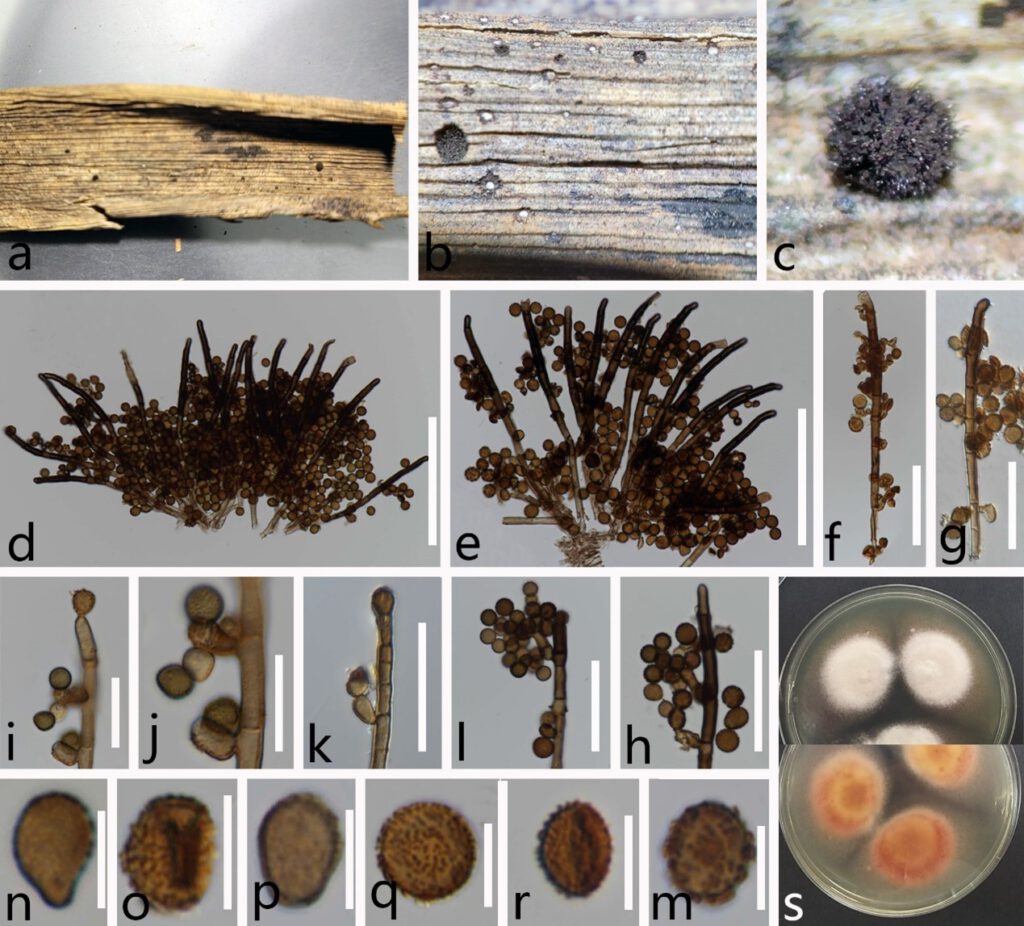Periconia epilithographicola Coronado-Ruiz, Avendaño, Escudero-Leyva, Conejo-Barboza, P. Chaverri & Chavarría, Scientific Reports 8 (no. 7492): 3 (2018)
MycoBank number: MB 825093; Index Fungorum number: IF 825093; Facesoffungi number: FoF 10660;
Saprobic on dead leaves of Ananas comosus. Sexual morph: Undetermined. Asexual morph: Hyphomycetous. Colonies effuse on the natural substrate, scattered, hairy, dark brown to dark. Mycelium composed of cottony, unbranched, hyphae forming dark clusters with conidia. Conidiophores (120–)140.5–178(–204) × 5–6.5 μm (x̅ = 159 × 5.9 µm, n = 40), macronematous, mononematous, unbranched, caespitose, erect, straight, brown to dark brown from basal to apical, septate, smooth. Conidiogenous cells 8−12 × 5−7 μm (x̄ = 10 × 6 μm, n = 20) holoblastic, monoblastic or polyblastic, determinate, discrete on stipe, intercalary, integrated, smooth to minutely verruculose, sub-globose to ellipsoid, brown. Conidia 9−11 μm diam. (x̄ = 10 μm, n =45), subglobose to globose, aseptate, light brown to dark brown, arising at one or more points on the curved surface of the conidiogenous cell, catenate, in branched chains, bud scars or disjunctors present at the site of attachment, smooth-walled to verruculose.
Culture characteristics Conidia germinated on PDA within 12 hr, reaching 25 mm diam. in 2 weeks at 25°C. Colonies on PDA with sparse, white mycelia on the surface, cottony, circular and flattened. The reverse of the colony is yellow with a white margin. Conidiophores and conidia are not observed in mature colonies.
Material examined Thailand, Chiang Rai Province, on dead leaves of Ananas comosus, 1 August 2020, X. G. Tian, P6−1 (MFLU 122163), living culture MFLUCC 21−0153.
Note: In the phylogenetic analyses, our new collection (MFLUCC 21−0153) clusters with the ex-type strain of Periconia epilithographicola (CBS 144017) with high bootstrap support (100% ML/1.00 PP, Fig. 1). Morphologically, our new isolate is almost identical to Periconia epilithographicola (CBS 144017, holotype) except for the size of conidiogenous cells (140.5–178 vs. 251.6–270 µm long). The nucleotide comparisons showed that there are 1 bp out of 554 of ITS differences between the new isolate (MFLUCC 21−0153) and Periconia epilithographicola (CBS 144017). Thus, we identified the new isolate as Periconia epilithographicola based on both phylogenetic analysis and morphological characters.

FIGURE 4. Periconia epilithographicola (MFLU xxxxx) a–c Colonies on host d–g Conidiophores h–l Conidiogenous cells and conidium m–r Conidiophores s Colony from above and below. Scale bars: d–e = 100 μm, f–i,k,l = 40 μm, j = 20 μm, m–r = 10 μm.
